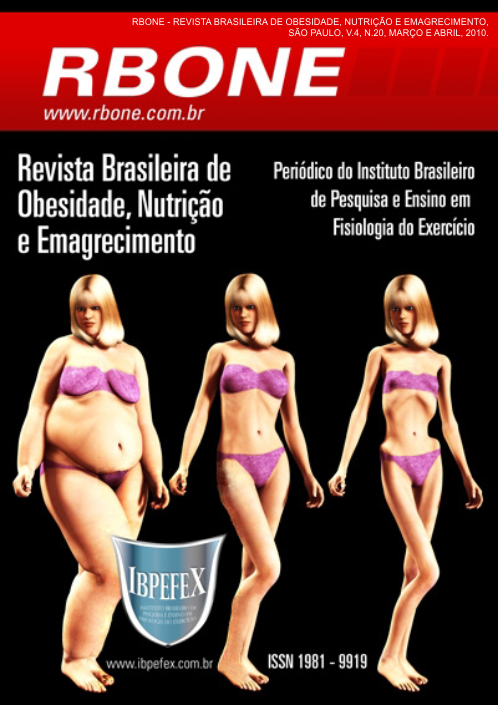Assessment of nutritional status and body fat percentage of students in the mode of bodybuilding
Abstract
The aim of this study was to profile the nutritional status and body fat percentage is simply the percentage of fat along with lean mass the body has in bodybuilding students of both sexes enrolled in an academy in the city of Pardons, State of Minas Gerais. This work includes a general on the assessment of nutritional status that signifies the student's health condition influenced by the consumption and use of nutrients and physical activity that isan important element in the prevention, maintenance and weight loss, making it a habit of life as natural as pleasurable.Methods: Of the 30 students enrolled in the sport of bodybuilding, we selected 10 students aged between 24-40 years of age. We used askinfold (Cescorf) to measure the skinfold measurements, where the student was wearing light clothes and easy to handle for ease of measurement for assessing body fat percentage, measurements were recorded in a physical assessment program (System for BodyFit Fitness Assessment Test) which gets the results of fat percentage. Weight and height were measured by mechanical scale with Filizola anthropometer (meter high) for nutritional assessment by calculating the BMI (Body Mass Index). Results: We observed that 10% is the perfect weight, 90% of the population is overweight, where overweight is 66.66% and 33.33% are overweight. In relation to body fat percentage, 100% of the population is above the ideal value. Conclusion: The students of the sport of bodybuilding are overweight and the percentage of excess body fat could be suggested to them a regular strength training along with a healthy diet with low calorie, promoting a reduction in body fat.
References
-Abrantes, M. M.; Lamounier, J. A.; Colosimo, E. A. Prevalência de sobrepeso e obesidade nas regiões nordeste e sudeste do Brasil. Rev. Assoc. Med. Bras. Vol. 49. Núm. 2. p.162-166. 2003.
-Camões, M.; Lopes, C. Fatores associados à atividade física na população portuguesa. Rev. Saúde Pública. Vol. 42. Núm. 2. p. 208-216. 2008.
-Liberali, R. Metodologia Científica Prática: um saber-fazer competente da saúde à educação. Florianópolis. 2008.
-Masson, C. R.; e colaboradores. Prevalência de sedentarismo nas mulheres adultas da cidade de São Leopoldo, Rio Grande do Sul, Brasil. Cad. Saúde Pública. Vol. 21. Núm. 6. p. 1685-1695. 2005.
-Pinheiro, A. R. O.; Freitas,S. F. T.; Corso, A. C. T. Uma abordagem epidemiológica da obesidade. Rev. Nutr. Vol. 17.Núm. 4. p. 523-533. 2004.
-Rego, A. L. V.; Chiara, V. L. Nutrição e excesso de massa corporal: fatores de risco cardiovascular em adolescentes. Rev. Nutr. Vol. 19. Núm. 6. p. 705-712. 2006.
-Secretaria de Estado da Saúde de São Paulo, Divisão de Doenças e Agravos Não-transmissíveis, Centro de Vigilância Epidemiológica "Prof. Alexandre Vranjac", Coordenadoria de Controle de Doenças. Instituição do Comitê Estadual para a Promoção da Alimentação Saudável e Prevenção de Doenças Crônicas Não Transmissíveis no Estado de São Paulo. Rev. Saúde Pública. Vol. 42. Núm. 2. p. 380-382. 2008.
-Tirapegui,J. Nutrição: fundamentos e aspectos atuais. 2ª edição. São Paulo. Atheneu. 2006.
-Theodoro, H.; Ricalde, S.R.; Amaro, F. S. Avaliação nutricional e autopercepção corporal de praticantes de musculação em academias de Caxias do Sul -RS. Rev Bras Med Esporte. Vol. 15. Núm. 4. p. 291-294. 2009.
Authors who publish in this journal agree to the following terms:
- Authors retain the copyright and grant the journal the right of first publication, with work simultaneously licensed under the Creative Commons Attribution License BY-NC which allows the sharing of the work with acknowledgment of the authorship of the work and initial publication in this journal.
- Authors are authorized to enter into additional contracts separately for non-exclusive distribution of the version of the work published in this journal (eg, publishing in institutional repository or book chapter), with acknowledgment of authorship and initial publication in this journal.
- Authors are allowed and encouraged to post and distribute their work online (eg, in institutional repositories or on their personal page) at any point before or during the editorial process, as this can bring about productive change as well as increase impact and impact. citation of published work (See The Effect of Free Access).






